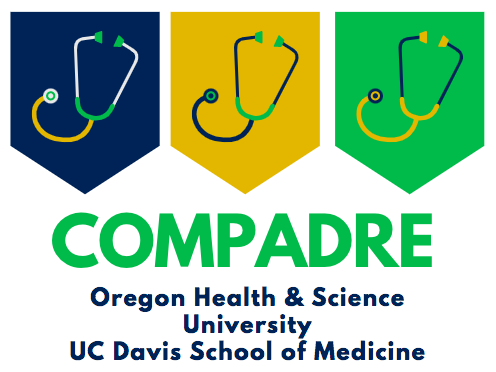Our Mission
To reach our long term mission of enhancing community health, COMPADRE seeks to achieve the following:
Innovate admissions practices into UME and GME to transform the composition and distribution of the physician workforce.
Recruit and retain students from diverse backgrounds and experiences who are committed to practicing in under-resourced settings. We aim to support students in all shortage specialties (i.e., emergency medicine, family medicine, general surgery, general internal medicine, obstetrics and gynecology, pediatrics, and psychiatry). Please note: all specialties may not be available at all times. To achieve this, we will collaborate with existing pathway programs, community colleges, community leaders and Federally Qualified Health Centers (FQHCs).
Employ a holistic admissions framework to evaluate applicants’ intention to work with underserved populations, and their “distance traveled” to consider the life experiences that have shaped their pathways.
Engage community and tribal advisors in the recruitment and admissions process.
Support low-income COMPADRE students by providing opportunities for scholarships and/or loan repayment options at each university.
Foster synergies and cross-collaborations between UME and GME programs to offer sustained, continuous pathways to medicine for COMPADRE students.
2. Redesign the UME to GME transition so students gain first-hand experience in their future clinical learning environments.
Students receive personal advising to develop their own Individual Learning Plans (ILPs). ILPs help integrate UME and GME by facilitating a smoother transition into a familiar, supportive clinical learning environment.
Community coaches assist learners in understanding the assets, social opportunities, and culture of their patients. In this manner, they ensure relevance of scholarly and quality improvement (QI) projects, and promote learner readiness for practice in these communities.
COMPADRE strengthens relationships with GME programs by hosting student rotations in GME programs, supporting student continuity panels with residents and facilitating the educational handover.
In addition, programs have the ability to offer a COMPADRE track through the match.
3. Redesign curriculum to foster new clinical, health system science, and advocacy skills among learners which will better prepare them to care for populations in under-resourced settings.
Address structural competency, population health, patient safety, and QI.
Learners will conduct a QI project with guidance from GME partners and from OHSU’s Primary Care Transformation curriculum for under-resourced settings.
Develop rural health competency domains and indigenous health competencies within a consistent framework with milestones and entrustable professional activities (EPAs).
Nurture competency domains for developing physician-citizens who adapt to scarce resources, unique local needs, changing team members, and fragile/precarious systems. In particular, foster the following virtues to help rural practitioners thrive:
Agency and courage
Adaptability
Collaboration and community-responsiveness
Comprehensiveness
Integrity
Abundance in the face of scarce resources
Reflective practice
Resilience
Cultivate indigenous health competencies in immersive environments with neighboring indigenous communities. By actively engaging with community members, learners are expected to practice cultural humility, and become more aware of culturally appropriate ways of practicing medicine in specific tribal settings. More specifically, they will learn from the community and incorporate:
Traditional ways of healing
Decolonizing practices
A sense of place and land-based teachings in health
Traditional ways of being and knowing
4. Enhance wellbeing and joy in practice by nurturing meaningful longitudinal relationships within a thriving learning community.
Develop a supportive learning community with centralized coaching and wellness promotion.
Opportunities to develop a personal wellness plan.
Exploration of relevant topics with on-site wellness faculty facilitator including: origin stories and narrative reflection, belonging and community, resilience and mental health, and a sense of purpose in medical training.
5. Reduce regional health disparities.
Consider members’ local perspectives to define relevant workforce needs and ensure learners develop skill sets that attend to the needs of communities they will serve.
Collaborate with New York University’s (NYU) Data Coordinating Center (DCC) and other population health centers to measure long-term health outcomes, and workforce needs (i.e., practice location and specialty choice).


